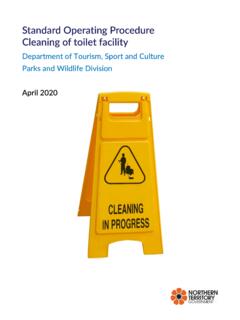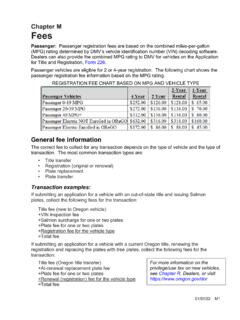Transcription of National Heavy Vehicle Inspection Manual V3
1 Copyright National Heavy Vehicle Regulator (2021) Version October 2021 This work is licensed under a Creative Commons Attribution-ShareAlike Australia Licence. To attribute this material, cite National Heavy Vehicle Regulator, National Heavy Vehicle Inspection Manual . While every attempt has been made to ensure the accuracy of the content of the National Heavy Vehicle Inspection Manual , it should not be relied upon as legal advice Contents Introduction 4 Section 1 - Vehicle Identification 8 Section 2 - Brakes 10 Section 3 - Couplings 16 Section 4 - Steering and Suspension 20 Section 5 - Wheels.
2 Tyres and Hubs 23 Section 6 - Structure and Body Condition 26 Section 7 - Seats and Seatbelts 31 Section 8 - Lights and Reflectors 34 Section 9 Mirrors and Indirect Vision Devices 38 Section 10 - Windscreens and Windows 40 Section 11 - Engine, Driveline and Exhaust 44 Section 12 - LPG, NG and Hydrogen and Electric Vehicles 47 Section 13 - Buses 51 Section 14 - Trailers 56 Section 15- Motorhomes, Caravans and Campervans 66 Section 16 - Vehicle Dimensions 68 Appendix A - Vehicle Category Codes and ADR Applicability Tables 71 Appendix B - Vehicle Modifications 73 National Heavy Vehicle Inspection Manual 4 of 73 Introduction 1.
3 Application The National Heavy Vehicle Inspection Manual (NHVIM) has been revised by the National Heavy Vehicle Regulator (NHVR) as part of its task to develop and introduce a single National approach to ensuring Heavy Vehicle roadworthiness. The NHVIM applies to all vehicles that have a gross Vehicle mass (GVM) or aggregate trailer mass (ATM) greater tonnes. The National Heavy Vehicle Inspection Manual (NHVIM) applies to all vehicles that have a gross Vehicle mass (GVM) or aggregate trailer mass (ATM) greater than tonnes.
4 It provides consistent criteria for when a Vehicle should fail a Heavy Vehicle Inspection and therefore be considered defective. The NHVIM details practical information about wear, damage or change to important systems regarding Vehicle in-service inspections for owners, operators and administrators in each state and territory. For a Vehicle to be considered roadworthy it must comply with the Heavy Vehicle ( Vehicle Standards) National Regulation (known as Vehicle Standards), and the Australian Design Rules (ADRs) relevant to the manufacture date of the Vehicle .
5 These contain mandatory requirements for the safe design, construction and maintenance of vehicles and for the control of emissions and noise. Relevant legislation as applicable in each jurisdiction should also be checked for requirements ( specific regulations for passenger transport vehicles). When using the NHVIM, the following principles are relevant: Equipment required by the Vehicle Standards or ADRs to be part of a Vehicle must be present and work properly Equipment that is essential for compulsory components to function, the safe operation of a Vehicle , or the control of its emissions, must be kept in good condition.
6 Equipment that is not required by the Vehicle Standards and has no direct effect on the Vehicle s safe operation or the control of its emissions does not have to function, as long as it does not interfere with compulsory equipment that is required Manufacturers recommendations relevant to the safety of particular Vehicle parts or to the control of emissions must be considered Test methods or other conditions have not been specified except where they are necessary to determine whether criteria are met. Examiners will utilise their qualifications and experience in Vehicle repairs and maintenance and refer to any relevant information regarding Vehicle manufacturer s specifications to ensure that the Vehicle meets the requirements of the Vehicle Standards or ADRs.
7 Relevant ADRs are noted at the beginning of each section of the NHVIM. Some of the ADRs may have been repealed or updated since publication of the NHVIM, however, depending on the age of the Vehicle being inspected, the ADR or aspects of the ADR may still be applicable. All relevant documents should be consulted for a complete list of the requirements. Introduction National Heavy Vehicle Inspection Manual 5 of 73 Some Inspection processes and standards apply only to certain Heavy vehicles. Similarly, a Heavy Vehicle may have been exempted from a Vehicle Standard, dimension or ADR1.
8 An ADR, Heavy Vehicle ( Vehicle Standards) National Regulation or Heavy Vehicle (Mass, Dimension and Loading) National Regulation developed after publication of the NHVIM may allow a variation or exemption. There are some common Vehicle types which are often provided exemptions from Vehicle Standards, dimensions or ADRs. Where such vehicles do not meet a standard, an exemption will be provided. Examples of these vehicles and there exemption types are provided in the table below. 2. Purpose The purpose of the NHVIM is to provide authorised officers (including safety compliance officers and police), approved Vehicle examiners (AVEs) and other Vehicle inspectors with a nationally consistent set of failure criteria to be applied when conducting a Heavy Vehicle Inspection .
9 It also provides Vehicle operators with an easy to follow set of requirements to know when a Vehicle is considered defective. 3. Scope The NHVIM will provide guidance to Authorised Officers, AVEs and other Vehicle inspectors on the National failure criteria for Heavy Vehicle roadworthiness. The NHVIM is intended to apply to in-service Heavy vehicles. Where Heavy vehicles have been modified, Authorised Officers and AVEs will need to assess the Vehicle against whatever approvals have been issued for the Heavy Vehicle in question.
10 These may be in the form of an engineer s report, a Vehicle Standards exemption, a second stage manufacturer identification plate or a modification plate or label which signifies that the modifications have been carried out to an accepted standard. The NHVIM will be supplemented by administrative processes and procedures. As Vehicle technologies are forever evolving it isn t possible to include all of them in the HVIM. However, the NHVR constantly observes these developing technologies and include them on our forward work program for consideration in future revisions to the NHVIM.





![Constitution of [insert name of association] Incorporated](/cache/preview/9/2/4/0/2/2/9/8/thumb-9240229875d40e70e812b7954282eb6c.jpg)










